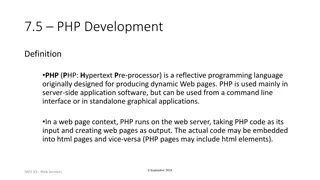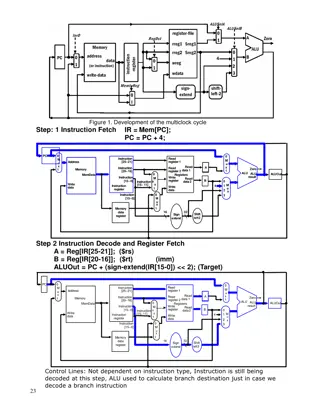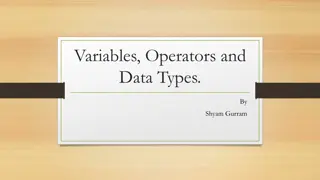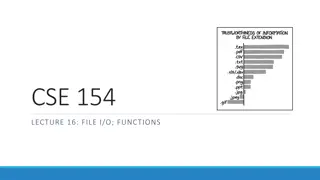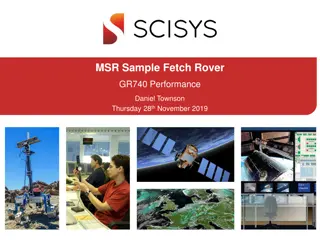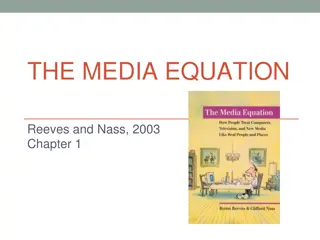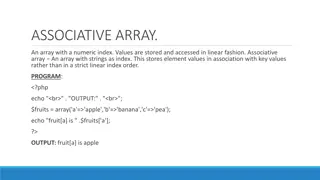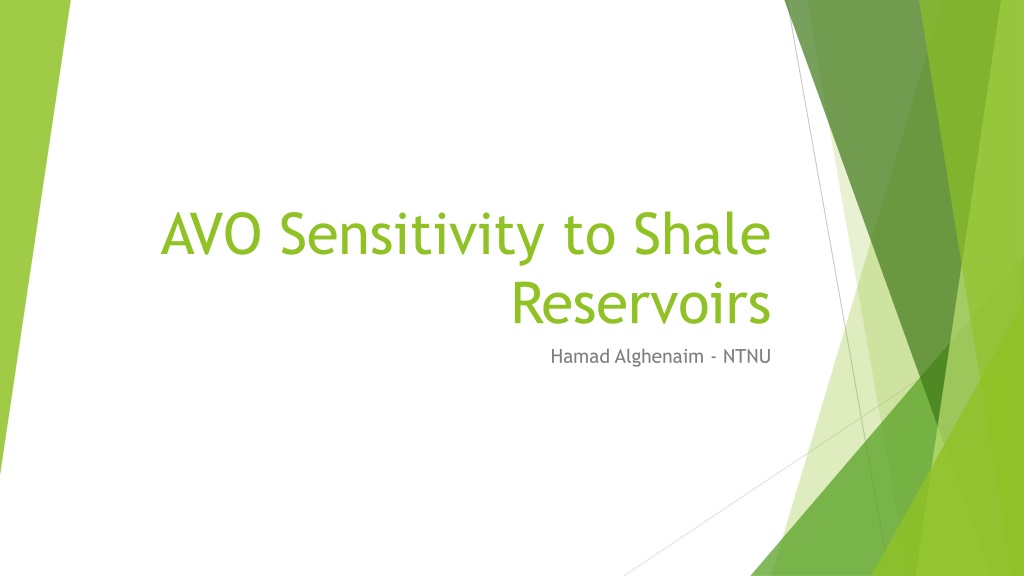
AVO Sensitivity to Shale Reservoirs - Laboratory Experiment Data Analysis
Explore the AVO sensitivity of shale reservoirs through laboratory experiments focusing on saturation, stress, frequency, anisotropy, and cracks. Results indicate increasing sensitivity with higher saturation levels, revealing valuable insights for shale reservoir characterization and analysis.
Download Presentation

Please find below an Image/Link to download the presentation.
The content on the website is provided AS IS for your information and personal use only. It may not be sold, licensed, or shared on other websites without obtaining consent from the author. Download presentation by click this link. If you encounter any issues during the download, it is possible that the publisher has removed the file from their server.
E N D
Presentation Transcript
AVO Sensitivity to Shale Reservoirs Hamad Alghenaim - NTNU
Outline Objectives Laboratory Experiment Data and Model Results Conclusion Next Acknowledgment
Objectives Examine unconventional shale reservoir sensitivity to: Saturation Stress Frequency Anisotropy Cracks
Laboratory Experiments Two experiments: Constant stress and varying saturation. (done previously data available) Constant saturation and varying confining and axial stresses. (April 2015 data processing) Measured ultra sonic velocities and low frequency velocities calculated from strain measurements. (E, ) Three different orientations in each expirement to calculate the stiffness tensor elements and anisotropy parameters.
Data and Model Saturation Frequency Crack density Stress Saturation Frequency Crack density Stress
Data and Model Vp=3000 m/s, Vs =1500 m/s, ,density=2.4 g/cc, epsilon=0.2 and delta=0.1 X Shale Oveburden clay rich shale Lab data Mancos Shale Reservoir silt rich shale
Two freq. (1 Hz & 21 Hz) while varying saturation 0.1 AVO Analysis 20+ deg 0.05 0 6-20 deg -0.05 0-6 deg -0.1 1 Hz S=0 1 Hz S=12 1 Hz S=12 Anis 1 Hz S=33 1 Hz S=55 1 Hz S=75 1 Hz S=86 1 Hz S=86 Anis 1 Hz S=100 21 Hz S=0 21 Hz S=12 21 Hz S=12 Anis 21 Hz S=33 21 Hz S=55 21 Hz S=75 21 Hz S=86 21 Hz S=86 Anis 21 Hz S=100 Reflectivity -0.15 -0.2 -0.25 -0.3 Increasing sensitivity to saturation -0.35 -0.4 0 5 10 15 20 25 30 35 40 45 50 Offset (m)
Shale samples measured at 1 Hz AVO Analysis 0.1 1 Hz S=0 1 Hz S=12 1 Hz S=12 Anis 1 Hz S=33 1 Hz S=55 1 Hz S=75 1 Hz S=86 1 Hz S=86 Anis 1 Hz S=100 0.05 0 -0.05 -0.1 Reflectivity -0.15 Higher separation between isotropic and anisotropic curves with increasing saturation Dimming with increasing saturation Trend starts at S=55 Lower saturations are random -0.2 -0.25 -0.3 -0.35 -0.4 0 5 10 15 20 25 30 35 40 45 50 Offset (degrees)
Shale samples measured at 21 Hz AVO Analysis 0.1 21 Hz S=0 21 Hz S=12 21 Hz S=12 Anis 21 Hz S=33 21 Hz S=55 21 Hz S=75 21 Hz S=86 21 Hz S=86 Anis 21 Hz S=100 0.05 0 -0.05 -0.1 Reflectivity -0.15 Similar observation to the previous slide but the whole curves are higher meaning brighter at low angles and dimmer at higher angles with increasing frequency -0.2 -0.25 -0.3 -0.35 -0.4 0 5 10 15 20 25 30 35 40 45 50 Offset (degrees)
Data with measured anisotropic parameters 0.1 AVO Analysis 1 Hz S=12 1 Hz S=12 Anis 1 Hz S=86 1 Hz S=86 Anis 21 Hz S=12 21 Hz S=12 Anis 21 Hz S=86 21 Hz S=86 Anis 0.05 0 -0.05 Higher zero crossing for higher saturation 17 deg vs 25 deg Dimming with angle: Increasing S Increasing Frequency anisotropy -0.1 Reflectivity -0.15 -0.2 -0.25 -0.3 -0.35 -0.4 0 5 10 15 20 25 30 35 40 45 50 Offset (degrees)
Data and Model Lab data Pierre Shale Oveburden clay rich shale Lab data Mancos Shale Reservoir silt rich shale
3 Freq. (1 Hz,21 Hz, 500kHz), 2 Sat. (12%,86%) 0.3 AVO Analysis 1 Hz S=12 1 Hz S=86 21 Hz S=12 21 Hz S=86 500 kHz S=12 500 kHz S=86 0.2 0.1 0 Reflectivity -0.1 -0.2 Intercept separation Change in polarity -0.3 -0.4 0 5 10 15 20 25 30 35 40 45 50 Offset (degrees)
1 Hz and varying saturation AVO Analysis 0.25 1 Hz S=12 1 Hz S=86 1 Hz S=0 1 Hz S=33 1 Hz S=75 1 Hz S=100 0.2 0.15 0.1 100 0.05 Reflectivity 86 0 75 -0.05 -0.1 Confirms Batzle 2010 -0.15 -0.2 -0.25 0 5 10 15 20 25 30 35 40 45 50 Offset (degrees)
Sensitivity to Cracks Tsvankin 1997 Rathore 1995
Adding vertical cracks to 1 Hz, S=12% & 86% 0.3 AVO Analysis 1 Hz no crack 12 1 Hz with crack 12 y 1 Hz with crack 12 x 1 Hz no crack 86 1 Hz with crack 86 y 1 Hz with crack 86 x 0.2 0.1 0 Reflectivity -0.1 -0.2 -0.3 -0.4 0 5 10 15 20 25 30 35 40 45 50 Offset (degrees)
Varying crack density (1 Hz, S=12%,86%) AVO Analysis 0.3 1 Hz no crack 12 1 Hz with crack 12 y 0.02 1 Hz with crack 12 x 0.02 1 Hz with crack 12 y 0.01 1 Hz with crack 12 x 0.01 1 Hz no crack 86 1 Hz with crack 86 y 0.02 1 Hz with crack 86 x 0.02 1 Hz with crack 86 y 0.01 1 Hz with crack 86 x 0.01 0.2 0.1 0 Reflectivity -0.1 -0.2 -0.3 -0.4 0 5 10 15 20 25 30 35 40 45 50 Offset (degrees)
Adding 500 kHz AVO Analysis 0.3 0.2 0.1 1 Hz no crack 12 1 Hz with crack 12 y 0.02 1 Hz with crack 12 x 0.02 1 Hz with crack 12 y 0.01 1 Hz with crack 12 x 0.01 1 Hz no crack 86 1 Hz with crack 86 y 0.02 1 Hz with crack 86 x 0.02 1 Hz with crack 86 y 0.01 1 Hz with crack 86 x 0.01 500 kHz no crack 12 500 kHz with crack 12 y 0.02 500 kHz with crack 12 x 0.02 500 kHz with crack 12 y 0.01 500 kHz with crack 12 x 0.01 500 kHz no crack 86 500 kHz with crack 86 y 0.02 500 kHz with crack 86 x 0.02 500 kHz with crack 86 y 0.01 500 kHz with crack 86 x 0.01 0 Reflectivity -0.1 -0.2 -0.3 -0.4 0 5 10 15 20 25 30 35 40 45 50 Offset (degrees)
Conclusion Sensitivity to saturation at angles higher than 20 Higher affect of anisotropy with higher saturation Dimming reflectivity with increasing saturation for angles higher than 20 Lack of saturation trend for low saturations until ~S=55% The higher the frequency the brighter the reflectivity at low angles and the dimmer it gets at higher angles At higher saturations, larger separations between zero intercepts of the different frequencies Small influence of cracks at angles higher than 30
Next Include the stress varying data in the analysis after processing Plot all the data on intercept-gradient for further analysis
Acknowledgment PhD student: Dawid Szewczyk Supervisors: Rune Holt / Per Avseth Sintef





